Kasimovian
The Kasimovian is a geochronologic age or chronostratigraphic stage in the ICS geologic timescale. It is the third stage in the Pennsylvanian (late Carboniferous), lasting from 307 to 303.7 Ma.[2] The Kasimovian stage follows the Moscovian and is followed by the Gzhelian. The Kasimovian saw an extinction event which occurred around 305 mya, referred to as the Carboniferous Rainforest Collapse.[3]
| Kasimovian | |
|---|---|
| 307.0 ± 0.1 – 303.7 ± 0.1 Ma | |
| Chronology | |
Key events in the Carboniferous -360 — – -355 — – -350 — – -345 — – -340 — – -335 — – -330 — – -325 — – -320 — – -315 — – -310 — – -305 — – -300 — – Key events of the Carboniferous Period Axis scale: millions of years ago | |
| Etymology | |
| Name formality | Formal |
| Usage information | |
| Celestial body | Earth |
| Regional usage | Global (ICS) |
| Time scale(s) used | ICS Time Scale |
| Definition | |
| Chronological unit | Age |
| Stratigraphic unit | Stage |
| Time span formality | Formal |
| Lower boundary definition | Not formally defined |
| Lower boundary definition candidates | FAD of the Fusulinid Protriticites or 1 million years older Montiparus montiparus[1] |
| Lower boundary GSSP candidate section(s) |
|
| Upper boundary definition | Not formally defined |
| Upper boundary definition candidates | FAD of the Conodont Idiognathodus simulator[1] |
| Upper boundary GSSP candidate section(s) |
|
Name and definition
The Kasimovian is named after the Russian city of Kasimov. The stage was split from the Moscovian in 1926 by Boris Dan'shin (1891-1941), who gave it the name Teguliferina horizon. The name was posthumously changed in Kasimov horizon by Dan'shin in 1947. The name Kasimovian was introduced by Georgy Teodorovich in 1949.
The base of the Kasimovian stage is at the base of the fusulinid biozone of Obsoletes obsoletes and Protriticites pseudomontiparus or with the first appearance of the ammonite genus Parashumardites. The top of the stage is close to the first appearances of the fusulinid genera Daixina, Jigulites and Rugosofusulina or the first appearance of the conodont Streptognathodus zethus.
Biozones
The Kasimovian is subdivided into three conodont biozones:
- Idiognathodus toretzianus Zone
- Idiognathodus sagittatus Zone
- Streptognathodus excelsus and Streptognathodus makhlinae Zone
Kasimovian life
Arthropods
| Arthropods of the Kasimovian | ||||
|---|---|---|---|---|
| Taxa | Presence | Location | Description | Images |
| Arthropleura | Pennsylvanian | Flénu Formation, Belgium Farrington Formation, Scotland Luisenthal Formation, Germany northeastern North America |
A 2 m (79 in) long millipede |  |
| Meganeura | Pennsylvanian | Commentry Shales Formation, France England |
A dragonfly with wingspans ranging from 65 cm (25.6 in) to over 70 cm (28 in) |  |
Cartilaginous fishes
| Chondrichthyes of the Kasimovian | ||||
|---|---|---|---|---|
| Taxa | Presence | Location | Description | Images |
| Janassa | Carboniferous to Lopingian | Bear Gulch Limestone, Nebraska & Minnelusa Formation, South Dakota, United States Ichinotani Formation, Japan |
a petalodontiform holocephalian |  |
†Temnospondyls
| Temnospondyli of the Kasimovian | ||||
|---|---|---|---|---|
| Taxa | Presence | Location | Description | Images |
| Actiobates | Pennsylvanian | Stanton Formation, Kansas, United States | ||
| Dendrerpeton | Joggins & Parrsboro Formations, Nova Scotia, Canada | 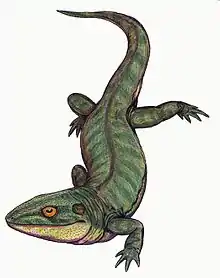 | ||
Reptiliomorphs
| Reptiliomorpha of the Kasimovian | ||||
|---|---|---|---|---|
| Taxa | Presence | Location | Description | Images |
| Desmatodon | Red Knob Formation, Pennsylvania; Sangre de Cristo Formation, Colorado; Cutler Formation, New Mexico | A diadectomorph | ||
| Solenodonsaurus | Kladno Formation, Czech Republic | 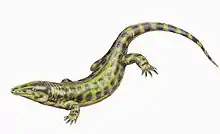 | ||
Eureptiles
| Eureptilia of the Kasimovian | ||||
|---|---|---|---|---|
| Taxa | Presence | Location | Description | Images |
| Brouffia | Nýřany site, Kladno Formation, Czech Republic | One of the most basal eureptiles. | ||
| Coelostegus | Nýřany site, Kladno Formation, Czech Republic | Possibly the basalmost known eureptile. | ||
Synapsids
| Synapsids of the Kasimovian | ||||
|---|---|---|---|---|
| Taxa | Presence | Location | Description | Images |
| Archaeovenator | Kasimovian-Gzhelian | Calhoun Shale, Kansas, United States | A basal varanopid | 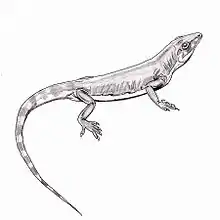 |
| Datheosaurus | Kasimovian-Asselian | Ludwikowice Formation, Nowa Ruda, Poland | A caseasaur | 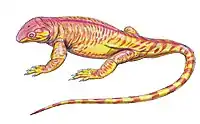 |
| "Haptodus" garnettensis | late Kasimovian | Garnett Quarry, Rock Lake Member, Anderson County, Stanton Formation, Lansing Group, Kansas, USA | A basal haptodontiform currently assigned to Haptodus, this species may require its own genus | |
| Ianthasaurus | Pennsylvanian | Stanton Formation, Kansas, United States | A basal edaphosaurid | 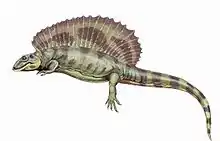 |
| Ianthodon | Pennsylvanian | Stanton Formation, Kansas, United States | A basal haptodontiform | |
| Kenomagnathus | Pennsylvanian | Stanton Formation, Kansas, United States | A haptodontiform |  |
| Ophiacodon | Kasimovian-Kungurian | Ada Formation, Oklahoma and possibly Joggins Formation, Nova Scotia, Canada | An ophiacodontid |  |
References
- "Global Boundary Stratotype Section and Point". International Commission of Stratigraphy. Retrieved 23 December 2020.
- Gradstein, F.M.; Ogg, J.G. & Smith, A.G.; 2004: A Geologic Time Scale 2004, Cambridge University Press.
- Sahney, S., Benton, M.J. & Falcon-Lang, H.J. (2010). "Rainforest collapse triggered Pennsylvanian tetrapod diversification in Euramerica" (PDF). Geology. 38 (12): 1079–1082. doi:10.1130/G31182.1.CS1 maint: multiple names: authors list (link)
Literature
- Dan'shin, V.M.; 1947: Geology and Mineral Resources of Moscow and its Surroundings, Izdat. Moskov. Obshch. Isp. Prir., Moscow, 308 pp. (in Russian).
- Menning, M.; Alekseev, A.S.; Chuvashov, B.I.; Davydov, V.I.; Devuyst, F.-X.; Forke, H.C.; Grunt, T.A.; Hance, L.; Heckel, P.H.; Izokh, N.G.; Jin, Y.-G.; Jones, P.J.; Kotlyar, G.V.; Kozur, H.W.; Nemyrovska, T.I.; Schneider, J.W.; Wang, X.-D.; Weddige, K.; Weyer, D. & Work, D.M.; 2006: Global time scale and regional stratigraphic reference scales of Central and West Europe, East Europe, Tethys, South China, and North America as used in the Devonian–Carboniferous–Permian Correlation Chart 2003 (DCP 2003), Palaeogeography, Palaeoclimatology, Palaeoecology 240(1-2): pp 318–372.
- Teodorovich, Georgy I. (1949). О подразделении верхнего карбона на ярусы [On the subdivision of the Upper Carboniferous into stages]. Doklady Akademii Nauk SSSR (in Russian). 67 (3): 537–540.
External links
- Carboniferous timescale at the website of the Norwegian network of offshore records of geology and stratigraphy
- Kasimovian, GeoWhen Database